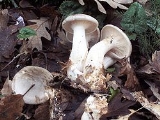
Clitocybe nebularis
Encyclopedia
Clitocybe nebularis or Lepista nebularis, commonly known as the clouded agaric or cloud funnel, is an abundant gilled fungus
which appears both in conifer-dominated forests and broad-leaved
woodland in Europe and North America. Appearing in Britain
from late summer to late autumn, it is edible
but causes gastric upsets in many individuals.
genus in 1871 by Paul Kummer
as Clitocybe nebularis. After much consideration by many mycologists, over some years, when it was placed for periods in both Lepista
, and Gymnopus
, it was placed back in Clitocybe with the specific epithet, and 1871 creditation it retains today.
Clitocybe nebularis var. alba Bataille (1911), differs only in having a milk white cap, and is very rare.
of the mushroom is 5–25 cm (2–8 in) in diameter, convex with an incurved margin, becoming plane to depressed in shape. Cap colours are generally greyish to light brownish-grey, and often covered in a whitish bloom when young. The surface of the cap is usually dry to moist, and radially fibrillose. The stem
is stout, swollen towards the base, becomes hollow with age, and is easily broken. It is usually somewhat lighter than the cap. The flesh is white, and very thick. It has a foul-smelling odour, which has been described as slightly farinaceous to rancid.
This species is host to the parasitic gilled mushroom Volvariella surrecta, which is found on older specimens.
It may be confused with the poisonous Entoloma sinuatum
both in Europe or North America, though this species has pink sinuate gills.
Fungus
A fungus is a member of a large group of eukaryotic organisms that includes microorganisms such as yeasts and molds , as well as the more familiar mushrooms. These organisms are classified as a kingdom, Fungi, which is separate from plants, animals, and bacteria...
which appears both in conifer-dominated forests and broad-leaved
Deciduous
Deciduous means "falling off at maturity" or "tending to fall off", and is typically used in reference to trees or shrubs that lose their leaves seasonally, and to the shedding of other plant structures such as petals after flowering or fruit when ripe...
woodland in Europe and North America. Appearing in Britain
United Kingdom
The United Kingdom of Great Britain and Northern IrelandIn the United Kingdom and Dependencies, other languages have been officially recognised as legitimate autochthonous languages under the European Charter for Regional or Minority Languages...
from late summer to late autumn, it is edible
Edible mushroom
Edible mushrooms are the fleshy and edible fruiting bodies of several species of fungi. Mushrooms belong to the macrofungi, because their fruiting structures are large enough to be seen with the naked eye. They can appear either below ground or above ground where they may be picked by hand...
but causes gastric upsets in many individuals.
Taxonomy
The species was first described and named as Agaricus nebularis in 1789 by August Johann Georg Karl Batsch. It was later placed in the ClitocybeClitocybe
Hundreds of species of mushrooms compose the fungus genus Clitocybe. They are characterized by white, off-white, buff, cream, pink, or light-yellow spores, gills running down the stem, and pale white to brown or lilac coloration. They are primarily saprotrophic, decomposing forest ground litter...
genus in 1871 by Paul Kummer
Paul Kummer
Paul Kummer was a priest, teacher, and scientist in Zerbst, Germany, known chiefly for his contribution to mycological nomenclature. Earlier classification of agarics by pioneering fungal taxonomist Elias Magnus Fries designated only a very small number of genera, with most species falling into...
as Clitocybe nebularis. After much consideration by many mycologists, over some years, when it was placed for periods in both Lepista
Lepista
Lepista is a deprecated genus of mushrooms, formerly grouped in the large genus Tricholoma and more recently found to be a synonym of Clitocybe. However, Clitocybe itself appears polyphyletic and may have to be split...
, and Gymnopus
Gymnopus
Gymnopus is a genus of fungus in the Marasmiaceae family. The genus has a widespread distribution and contains about 300 species.-Representative species:*Gymnopus dryophilus*Gymnopus fusipes*Gymnopus peronatus*Gymnopus semihirtipes...
, it was placed back in Clitocybe with the specific epithet, and 1871 creditation it retains today.
Clitocybe nebularis var. alba Bataille (1911), differs only in having a milk white cap, and is very rare.
Description
The capPileus (mycology)
The pileus is the technical name for the cap, or cap-like part, of a basidiocarp or ascocarp that supports a spore-bearing surface, the hymenium. The hymenium may consist of lamellae, tubes, or teeth, on the underside of the pileus...
of the mushroom is 5–25 cm (2–8 in) in diameter, convex with an incurved margin, becoming plane to depressed in shape. Cap colours are generally greyish to light brownish-grey, and often covered in a whitish bloom when young. The surface of the cap is usually dry to moist, and radially fibrillose. The stem
Stipe (mycology)
thumb|150px|right|Diagram of a [[basidiomycete]] stipe with an [[annulus |annulus]] and [[volva |volva]]In mycology a stipe refers to the stem or stalk-like feature supporting the cap of a mushroom. Like all tissues of the mushroom other than the hymenium, the stipe is composed of sterile hyphal...
is stout, swollen towards the base, becomes hollow with age, and is easily broken. It is usually somewhat lighter than the cap. The flesh is white, and very thick. It has a foul-smelling odour, which has been described as slightly farinaceous to rancid.
This species is host to the parasitic gilled mushroom Volvariella surrecta, which is found on older specimens.
It may be confused with the poisonous Entoloma sinuatum
Entoloma sinuatum
Entoloma sinuatum is a poisonous mushroom found across Europe and North America. Some guidebooks refer to it by its older scientific names of Entoloma lividum or Rhodophyllus sinuatus...
both in Europe or North America, though this species has pink sinuate gills.

